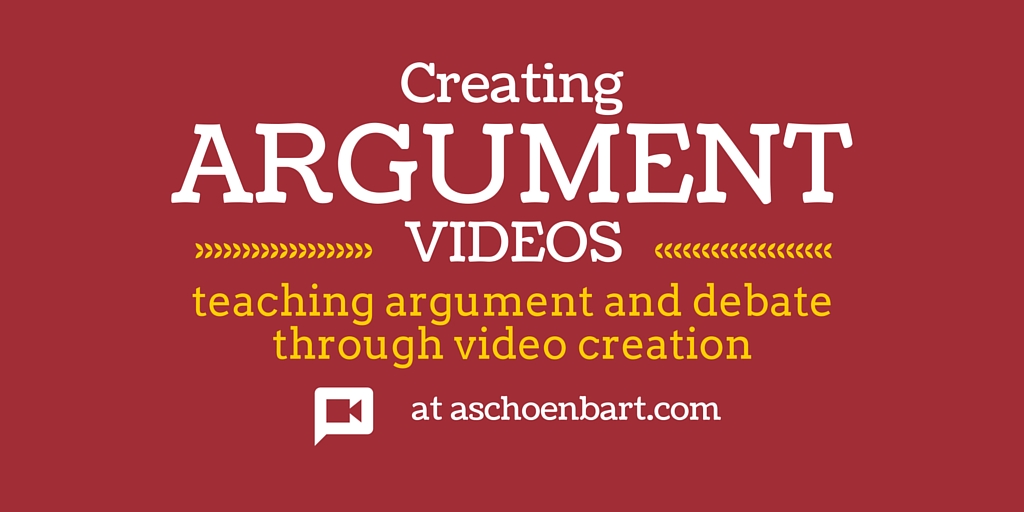Creating Video Arguments: Sharing Lessons & Products

Argument writing is a major part of my English 10 curriculum; an argument essay is the major task on the New York State Common Core English Regents, and it’s an essential fundamental skill. Students need to know how to craft, develop, organize, and present their writing and ideas. Whether it’s convincing mom for the later curfew, succeeding on the SAT essay, or making a sales pitch at work, these are skills that matter.
I don’t spend too much time directly addressing the dreaded Argument Essay for most of the year. Instead I focus on developing the skills: crafting claims, using evidence, recognizing counterclaim, communicating effective ideas, and so on. Then, we’re usually able to apply them to the writing without too much difficulty. For the past two years, I’ve tried to add some more fun into it by focusing on debate and create.
To start the unit, my students are randomly assigned a topic and have fifteen minutes to prepare an argument and debate with another group. We then debrief and start to reflect on the elements of argument to help us move into the more formal dialogue and instruction. Then comes the argument video.
Students’ Task
Argue, create, and compete! Then, decide your peers’ fate! Develop, craft, and film an argument about a selected topic. Your job is to convince your audience that your argument is right by effectively incorporating the four parts of a good argument: claim, counterclaim, specific evidence, and organization.
I created a list of high-interest topics for my students. In self-selected groups, students signed up for the yes or no side of a topic, which ranged from “Should schools have uniforms?” to “Would Batman beat Superman in a fight?” Then, they worked to craft, develop, organize, script, and film their videos.
I provided a rubric that assessed claim, counterclaim, evidence, organization, and preparation. Then they were off to work. The videos were capped at 90 seconds and shared for my students to watch and vote on. Each video received feedback and students voted on the winning arguments, providing evidence to support their choices.
For more, check out the assignment sheet here.
Tech & Learning Newsletter
Tools and ideas to transform education. Sign up below.
The Logistics
I was smart this year--or at least smarter. I introduced the task and asked students to form groups before working in class. This allowed me determine the the number of topics necessary. With 28 groups of students from my three class sections, I needed 14 topics. Students selected their topics on a first come, first served basis, and I used the Google Forms add-on Choice Elimator 2 to remove choices as they were selected. This ensured that every topic was eventually selected and we had an even split of yes and no videos.
Students then submitted the link to their video, which was uploaded to YouTube on another Google Form. I didn’t require any fancy editing--students recorded on everything from an iPhone to Chromebook to DSLR camera.
Then, after I organized their submissions, they were assigned to watch two different arguments (four videos) and provide feedback for their peers.
The Products
As I write this, I just finished reviewing the student' work. And it’s awesome. Most of the videos are so much stronger than I expected and really show an understanding of the elements of argument.
For this project, I allowed students to opt into me sharing their work. Usually, all of our products and classroom learning are public but since these videos had to have my students featured on camera, I gave them the option to allow me to share them here and on Twitter.
Below, find a few of the videos that really impressed me. At the end, find both sides of a debate and share your vote in the comments!
Do celebrities make for bad role models?
YES! By Sarah, Jillian, and Emma
Should schools ban homework?
NO! By Grant
Should schools have open campuses?
NO! By Zoe, Sri, and Lexi
Should high school students be required to do community service?
YES! By Thomas
NO! By Jimmy
Who wins, fair reader? Thomas or Jimmy? Share your thoughts on their arguments, the project, or your strategies and tools for teaching argument or content creation in the comments or on Twitter.
cross posted at www.aschoenbart.com
Adam Schoenbart is a high school English teacher, Google Education Trainer, and EdD candidate in Educational Leadership. He teaches grades 10-12 in a 1:1 Chromebook classroom at Ossining High School in Westchester County, NY and received the 2014 LHRIC Teacher Pioneer Award for innovative uses of technology that change teaching and learning. Read more at The SchoenBlog and connect on Twitter @MrSchoenbart.
